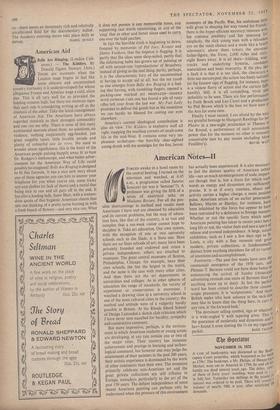American Notes—II
FORCED awake in a hotel room by ithe central heating, I turned on the television and watched, at 6.45 a.m., a programme called Sunrise Semester (or was it Seminar'?). A professor was giving the fifth of a i series of analytical talks on
Madame Bovary. For all the pos- sible shortcomings in method and results most Americans I have met are obsessed by education and its current problems, but the map of educa- tion here, like that of the country, is so vast and complex that a ten-week visitor cannot hope to decipher it. Take art education. Our own system, with the exception of one or two university schools such as the Slade, is a State one. Here there are no State schools of art; many have been privately founded and endowed and retain a private independence; others are attached to museums. The great central museums of Boston, Philadelphia, Chicago, for example, have their own schools, the last the largest in the world, and the same is the case with many other cities. And then there are the art departments in universities and colleges. As in other spheres of education the range of standards, the variety of experiment or conservatism is enormous. I watched a drawing class ip a university school in one of the most cultured cities in the country; the method and attitude were of a vulgarity hardly possible in Britain. At the Rhode Island School of Design I attended a sketch club criticism which I have never seen equalled for lucidity, sympathy and constructive comment.
But more impressive, perhaps, is the environ- ment in which American students or young artists are developing, at any rate outside one or two of the major cities. Their country has immense achievement and prestige in learning and techno- logical command, but however one may judge the attainments of their painters in the past 200 years, their artistic experience is dominated by the work of other continents than their own. The museums primarily celebrate non-American art and the great private collections are still tributes to Europe, nowadays particularly to the art of the past 150 years. The defiant independence of some recent American painting can perhaps only be understood when the pressure of this environment
has actually been experienced. It is also necessary to feel the distinct quality of American urban life—not so much an enlargement of scale, import- ant though that is, but a force for which such words as energy and dynamism are, sufficiently precise. It is as if every creature, object and activity carries a higher charge, a more positive pulse. American artists of an earlier generation, Bellows, Martin or Hartley, for instance, have been inhabited by this force but appear to have been restrained by a deference to foreign masters. Whether or not the specific form which some American painting has taken in recent years has a long life or not, the visitor feels and sees a spirit of release and avowed independence. A large, mixed exhibition, such as I saw a few days ago in St. Louis, a city with a fine museum and great modern, private collections, is fundamentallY distinct from anything elsewhere for all its variety of intentions and accomplishment.
FOOTNOTE.—The past few weeks have seen the ceremonial emergence of the 1958 cars, and Phineas T. Barnum could not have done better in announcing the arrival of Jumbo (American advertising reminds one more of Barnum than of anything more up to date). At last the perfect word has been coined to describe these cinema' scopic presences. It is `sculpturamic.' And those British males who look askance at the sack-line may like to know that the thing here, in cars at any rate, is 'the forward look.' The dominant selling symbol, sign or whatever is a wide-angled V with tapering arms. This lc the guarantee of modernity and dynamism and I hav' found it even dotting the i's on my cigarette










































































 Previous page
Previous page